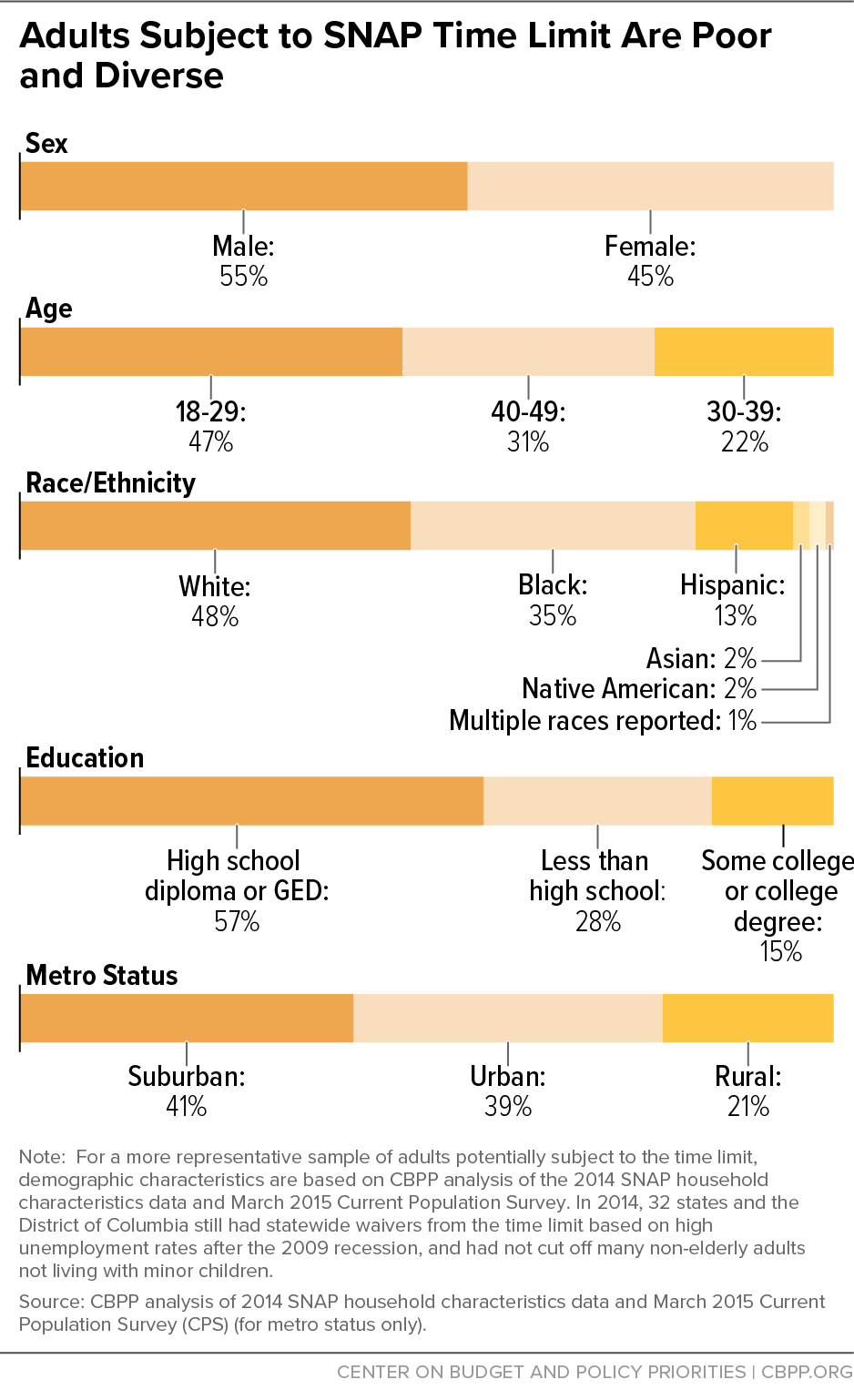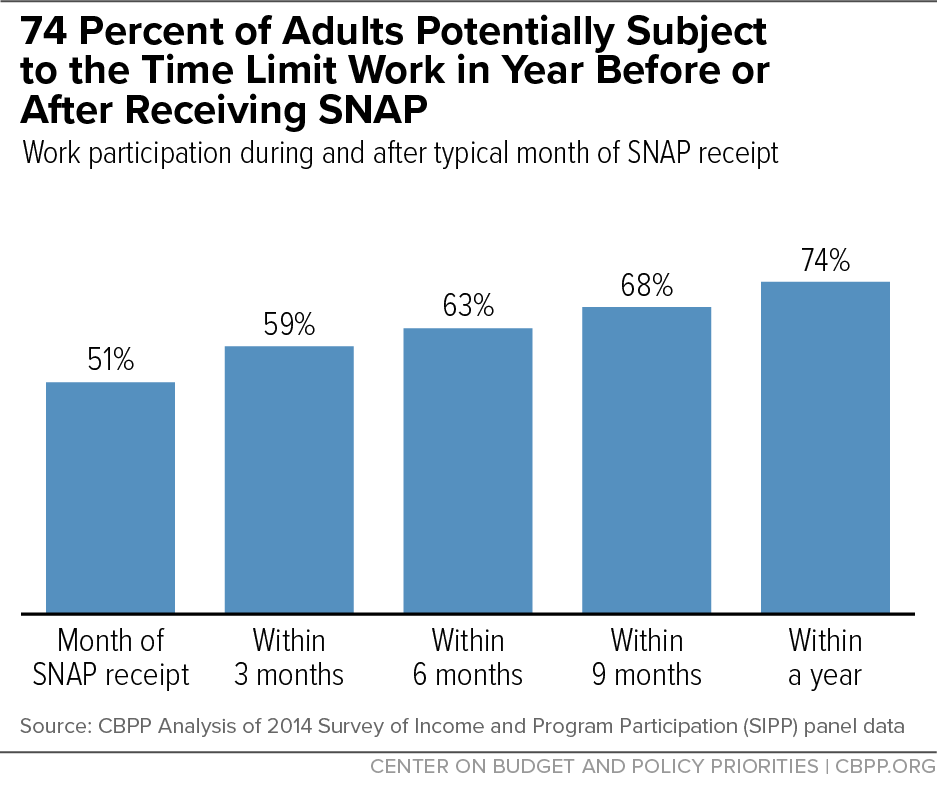Permanently End the SNAP Cut-Off to Support a More Equitable Recovery
End Notes
[1] Joseph Llobrera et al., “A Frayed and Fragmented System of Supports for Low-Income Adults Without Minor Children,” CBPP, January 28, 2021, https://www.cbpp.org/research/poverty-and-inequality/a-frayed-and-fragmented-system-of-supports-for-low-income-adults.
[2] Not all non-elderly adults without children in their home are actually subject to the time limit, as some may meet certain other exceptions from the time limit, live in areas with waivers from the time limit, work at least 20 hours a week, or be exempt from general SNAP work requirements. For more information, see www.fns.usda.gov/snap/able-bodied-adults-without-dependents-abawds.
[3] Brynne Keith-Jennings and Raheem Chaudhry, “Most Working-Age SNAP Participants Work, But Often in Unstable Jobs,” CBPP, March 15, 2018, https://www.cbpp.org/research/food-assistance/most-working-age-snap-participants-work-but-often-in-unstable-jobs.
[4] For more on how scheduling practices in low-wage jobs make it difficult for SNAP and other program participants to meet program requirements for specific hours of work, see Michael Karpman, Heather Hahn, and Anuj Gangopadhyaya, “Precarious Work Schedules Could Jeopardize Access to Safety Net Programs Targeted by Work Requirements,” Urban Institute, June 11, 2019, https://www.urban.org/research/publication/precarious-work-schedules-could-jeopardize-access-safety-net-programs-targeted-work-requirements.
[5] Ohio Association of Food Banks, “Franklin County Comprehensive Report on Able-Bodies Adults Without Dependents, 2014-2015,” October 14, 2015, http://admin.ohiofoodbanks.org/uploads/news/ABAWD_Report_2014-2015-v3.pdf.
[6] This range reflects a difference in data sources. CBPP analyses of USDA’s administrative data show that 27 percent of adults participating in SNAP who are potentially subject to the time limit worked in a typical month of 2018. In addition, CBPP analyses of the Census Bureau’s 2014 Panel of the Survey of Income and Program Participation (SIPP) show that 51 percent of these adults worked in 2015 in the month that they received SNAP. There are reasons for the differences in the results between the USDA data and the Census SIPP data. SIPP is a household survey, which means that respondents must have a fixed residence, but SNAP reaches many homeless households and other more transient households, who may be less likely to be employed while receiving SNAP. These people may show up in the USDA data but not the SIPP data. At the same time, work that households are not required to report for SNAP purposes may be captured by the SIPP data, but not by USDA’s. (Some work may not be required to be reported for SNAP either because it is irregular or isn’t expected to continue or because, under SNAP’s “simplified reporting” rules, changes in circumstances need only be reported at six-month intervals unless they raise household income above 130 percent of the poverty level.)
[7] Research conducted on the impact of the time limit following its enactment in 1996 found that three-quarters of all low-income adults who weren’t living with minor children and didn’t have a severe disability (not just those on SNAP) worked in 1997, while 86 percent were in the labor force (that is, either working or actively looking for work). See Stephen Bell and Jerome Gallagher, “Prime-Age Adults without Children or Disabilities: The ‘Least Deserving of the Poor’—or Are They?” Assessing the New Federalism Policy, Urban Institute, February 2001, https://www.urban.org/sites/default/files/publication/61286/310269-Prime-Age-Adults-without-Children-or-Disabilities.PDF. Although USDA’s administrative data may not be sufficiently reliable to draw firm conclusions, they suggest that, in a typical month in 2018, half (50 percent) of all adults subject to the time limit who were not working were looking for work.
[8] Chad Stone and Matt Saenz, “Labor Market Weaker Than Headline Numbers Suggest,” CBPP, March 1, 2021, https://www.cbpp.org/research/economy/labor-market-weaker-than-headline-numbers-suggest. (These figures were also updated in a thread by Chad Stone, at https://twitter.com/ChadCBPP/status/1378004433875955721.)
[9] CBPP, “Tracking the COVID-19 Recession’s Effects on Food, Housing, and Employment Hardships,” updated April 8, 2021, https://www.cbpp.org/research/poverty-and-inequality/tracking-the-covid-19-recessions-effects-on-food-housing-and.
[10] Chad Stone, “Rescue Act Extends Unemployment Benefit Programs That Help Millions of Unemployed Workers and Their Families,” CBPP, March 12, 2021, https://www.cbpp.org/blog/rescue-act-extends-unemployment-benefit-programs-that-help-millions-of-unemployed-workers-and.
[11] Chad Stone, “Robust Unemployment Insurance, Other Relief Needed to Mitigate Racial and Ethnic Unemployment Disparities,” CBPP, August 5, 2020, https://www.cbpp.org/research/economy/robust-unemployment-insurance-other-relief-needed-to-mitigate-racial-and-ethnic.
[12] LaDonna Pavetti, “Work Requirements Don’t Cut Poverty, Evidence Shows,” CBPP, updated June 7, 2016, https://www.cbpp.org/research/poverty-and-inequality/work-requirements-dont-cut-poverty-evidence-shows.
[13] See Elizabeth Dagata, “Assessing the Self-Sufficiency of Food Stamp Leavers,” Economic Research Service, USDA, September 2002, https://www.ers.usda.gov/publications/pub-details/?pubid=46645, for a summary of in-depth studies in Arizona, Illinois, Iowa, and South Carolina. See also individual reports for Iowa.
[14] Wenhui Feng, “The Effects of Changing SNAP Work Requirement on the Health and Employment Outcomes of Able-Bodied Adults without Dependents,” Journal of the American College of Nutrition, 2021, https://doi.org/10.1080/07315724.2021.1879692; Colin Gray et al., “Employed in a SNAP? The Impact of Work Requirements on Program Participation and Labor Supply,” August 2020, available at SSRN, http://dx.doi.org/10.2139/ssrn.3676722; Jeehoon Han, “The Impact of SNAP Work Requirements on Labor Supply,” August 27, 2020, available at SSRN, https://papers.ssrn.com/sol3/papers.cfm?abstract_id=3296402; Leighton Ku et al., “The Effects of SNAP Work Requirements in Reducing Participation and Benefits from 2013 to 2017,” American Journal of Public Health, August 15. 2019; Brian Stacy, Erik Scherpf, and Young Jo, “The Impact of SNAP Work Requirements,” working paper, https://www.aeaweb.org/conference/2019/preliminary/paper/Z8ZhzBZt.
[15] Erin Brantley, Drishti Pillai, and Leighton Ku, “Association of Work Requirements with Supplemental Nutrition Assistance Program Participation by Race/Ethnicity and Disability Status, 2013-2017,” JAMA Network Open, June 26, 2020, https://jamanetwork.com/journals/jamanetworkopen/fullarticle/2767673.
[16] LaDonna Pavetti, “TANF Studies Show Work Requirement Proposals for Other Programs Would Harm Millions, Do Little to Increase Work,” Center on Budget and Policy Priorities, November 13, 2018, https://www.cbpp.org/research/family-income-support/tanf-studies-show-work-requirement-proposals-for-other-programs.
[17] Dagata, op cit.
[18] Feng, op. cit.
[19] Heather Hahn et al., “SNAP Work Requirements in Arkansas for Adults without Dependents or Disabilities,” Urban Institute, 2019, https://www.urban.org/sites/default/files/publication/101112/snap_work_requirements_in_arkansas_for_adults_without_dependents_or_disabilities_6.pdf.
[20] Christian A. Gregory and Partha Deb, “Does SNAP Improve Your Health?” Food Policy, Vol. 50, pp. 11-19, 2015, http://www.sciencedirect.com/science/article/pii/S0306919214001419.
[21] Rachel Garfield, Robin Rudowitz, and MaryBeth Musumeci, “Implications of a Medicaid Work Requirement: National Estimates of Potential Coverage Losses,” Kaiser Family Foundation, June 27, 2018, https://www.kff.org/medicaid/issue-brief/implications-of-a-medicaid-work-requirement-national-estimates-of-potential-coverage-losses/.




